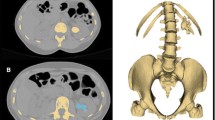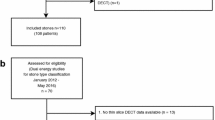Abstract
Objectives
To determine if calcium deposits in the papillae can be identified by unenhanced computed tomography (uCT) even before renal stones develop.
Methods
A retrospective review of 413 patients with calculi identified 31 patients (stone-forming group) with a history of urinary tract calculi with a calculus demonstrated by uCT and a stone-free uCT before calculi had developed. The control group (n = 31) was composed of live kidney donors with no history of calculi and a stone-free uCT. CT attenuation was measured in all CTs using two regions of interest of 0.05 cm2 and 0.1 cm2 over the tip and the neighbouring area of the papillae. Student's and Wilcoxon t-tests were used for comparing results in the two groups.
Results
The attenuation of the tip of the papilla was higher in the stone-forming group when compared to the controls after (45.2 HU versus 32.1 HU, P = 0.001) and even before frank calculi had developed (44.2 HU versus 32.1 HU, P = 0.003). There was no significant difference in papillary attenuation in the stone group before and after calculi had developed (45.2 HU versus 44.2 HU, P = 0.82).
Conclusion
Stone-forming patients exhibit higher papillary density even before calculi develop. This could define a population at risk of developing calculi.
Key Points
• Unenhanced CT shows high density papillae in patients who subsequently develop calculi.
• These probably correlate with Randall’s plaques.
• Subjects at high risk of developing stone disease could be identified.
• Targeted prophylaxis might be helpful.



Similar content being viewed by others
Abbreviations
- CG:
-
Control group
- ROI:
-
Region of interest
- SG:
-
Stone group
- SGPS:
-
Stone group previous to stone formation
- HU:
-
Hounsfield units
- CT:
-
Computed tomography
- SD:
-
Stone disease
References
Tiselius HG (2003) Epidemiology and medical management of stone disease. BJU Int 91:758–767
Randall A (1940) Papillary pathology as a precursor of primary renal calculus. J Urol 44:580
Evan AP, Lingeman JE, Coe FL, Parks JH, Bledsoe SB, Shao Y, Sommer AJ, Paterson RF, Kuo RL, Grynpas M (2003) Randall's plaque of patients with nephrolithiasis begins in basement membranes of thin loops of Henle. J Clin Invest 111:607–616
Matlaga BR, Coe FL, Evan AP, Lingeman JE (2007) The role of Randall's plaques in the pathogenesis of calcium stones. J Urol 177:31–38
Low RK, Stoller ML (1997) Endoscopic mapping of renal papillae for Randall's plaques in patients with urinary stone disease. J Urol 158:2062–2064
Evan A, Lingeman J, Coe FL, Worcester E (2006) Randall's plaque: pathogenesis and role in calcium oxalate nephrolithiasis. Kidney Int 69:1313–1318
Miller NL, Gillen DL, Williams JC Jr, Evan AP, Bledsoe SB, Coe FL, Worcester EM, Matlaga BR, Munch LC, Lingeman JE (2009) A formal test of the hypothesis that idiopathic calcium oxalate stones grow on Randall's plaque. BJU Int 103:966–971
Kim SC, Coe FL, Tinmouth WW, Kuo RL, Paterson RF, Parks JH, Munch LC, Evan AP, Lingeman JE (2005) Stone formation is proportional to papillary surface coverage by Randall's plaque. J Urol 173:117–119
Miller NL, Williams JC Jr, Evan AP, Bledsoe SB, Coe FL, Worcester EM, Munch LC, Handa SE, Lingeman JE (2010) In idiopathic calcium oxalate stone-formers, unattached stones show evidence of having originated as attached stones on Randall's plaque. BJU Int 105:242–245
Williams JC Jr, Matlaga BR, Kim SC, Jackson ME, Sommer AJ, McAteer JA, Lingeman JE, Evan AP (2006) Calcium oxalate calculi found attached to the renal papilla: preliminary evidence for early mechanisms in stone formation. J Endourol 20:885–890
Smith RC, Verga M, McCarthy S, Rosenfield AT (1996) Diagnosis of acute flank pain: value of unenhanced helical CT. AJR Am J Roentgenol 166:97–101
Eisner BH, Iqbal A, Namasivayam S, Catalano O, Kambadakone A, Dretler SP, Sahani DV (2008) Differences in computed tomography density of the renal papillae of stone formers and non-stone-formers: a pilot study. J Endourol 22:2207–2210
Bhuskute NM, Yap WW, Wah TM (2009) A retrospective evaluation of Randall's plaque theory of nephrolithiasis with CT attenuation values. Eur J Radiol 72:470–472
Mostafavi MR, Ernst RD, Saltzman B (1998) Accurate determination of chemical composition of urinary calculi by spiral computerized tomography. J Urol 159:673–675
Garant M, Bonaldi VM, Taourel P, Pinsky MF, Bret PM (1998) Enhancement patterns of renal masses during multiphase helical CT acquisitions. Abdom Imaging 23:431–436
Dixon AK, Ashford NS, Sherwood T (1988) Dense renal papillae: a quantitative study using computed tomography. Nephron 49:328–330
Tublin ME, Tessler FN, McCauley TR, Kesack CD (1997) Effect of hydration status on renal medulla attenuation on unenhanced CT scans. AJR Am J Roentgenol 168:257–259
Starinsky R, Barr J, Lushkov G, Segal M, Manor A, Golik A (1995) CT of renal densities caused by intravenous infusion of antibiotics. J Comput Assist Tomogr 19:228–231
Kumar R, Wang ZJ, Fu Y, Forsythe C, Webb EM, Yeh BM (2010) Visualization of renal medullary hyperattenuation at unenhanced CT: what is the effect of furosemide administration? Radiology 255:495–500
Hsu CT, Wang ZJ, Yu AS, Gould RG, Fu Y, Joe BN, Qayyum A, Breiman RS, Coakley FV, Yeh BM (2008) Physiology of renal medullary tip hyperattenuation at unenhanced CT: urinary specific gravity and the NaCl concentration gradient. Radiology 247:147–153
Author information
Authors and Affiliations
Corresponding author
Rights and permissions
About this article
Cite this article
Ciudin, A., Luque Galvez, M.P., Salvador Izquierdo, R. et al. Unenhanced CT findings can predict the development of urinary calculi in stone-free patients. Eur Radiol 22, 2050–2056 (2012). https://doi.org/10.1007/s00330-012-2463-9
Received:
Revised:
Accepted:
Published:
Issue Date:
DOI: https://doi.org/10.1007/s00330-012-2463-9




